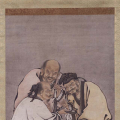Welcome home! Please contact lincoln@icrontic.com if you have any difficulty logging in or using the site. New registrations must be manually approved which may take several days. Can't log in? Try clearing your browser's cookies.
What kind of meditation did the Buddha teach?
 DaltheJigsaw
Mountain View Veteran
DaltheJigsaw
Mountain View Veteran
Truthfully speaking, no one clearly knows; however, we have a few good hints about the nature of the practice he might have taught from some of the Buddhist scriptures. From the above scripture, it is clear Buddha felt that unless one was using a correct method, one could not expect to gain Nirvana—the fully awakened state of absolute freedom and enlightenment.
Buddha also spoke of two qualities that he thought were fundamental to the fully-awakened state: Tranquility and Insight.
Two things will lead you to supreme understanding. What are those two?
Tranquility and Insight.
Photo: Kim
If you develop tranquility, what benefit can you expect? Your mind will develop.
The benefit of a developed mind is that you are no longer a slave to your impulses.
If you develop insight, what benefit will it bring? You will find wisdom.
And the point of developing wisdom is that it brings you freedom from the blindness of ignorance.
A mind held bound by unconsidered impulse and ignorance can never develop true understanding. But by way of tranquility and insight the mind will find freedom.~ Anguttara Nikaya
It is interesting that the two most popular forms of Buddhist meditation that are taught today are called Samatha and Vipassana.
Samatha meditation is based on the intention and persistent effort on the part of the meditator to concentrate the mind on some specific object of meditation: the goal being to develop the ability of the mind to concentrate because when the mind is in a highly concentrated state, it is known to be tranquil and such a mind, it is thought, would make deep insight possible.
Since Buddha explained that only the right method would bring the fruit, it would be valuable to explore whether Samatha meditation, as it’s understood and practiced today, is the right method to bring tranquility to the mind. The term Samatha actually means calmness or tranquility: an integrated state where the mind is not in any way excited or active. It is directly related to the term Samadhi, the state in which the mind is completely settled and unwavering and is effortlessly held in a fully concentrated state.
http://www.elephantjournal.com/2011/07/the-buddhas-meditation-dr-evan-finkelstein/
Buddha also spoke of two qualities that he thought were fundamental to the fully-awakened state: Tranquility and Insight.
Two things will lead you to supreme understanding. What are those two?
Tranquility and Insight.
Photo: Kim
If you develop tranquility, what benefit can you expect? Your mind will develop.
The benefit of a developed mind is that you are no longer a slave to your impulses.
If you develop insight, what benefit will it bring? You will find wisdom.
And the point of developing wisdom is that it brings you freedom from the blindness of ignorance.
A mind held bound by unconsidered impulse and ignorance can never develop true understanding. But by way of tranquility and insight the mind will find freedom.~ Anguttara Nikaya
It is interesting that the two most popular forms of Buddhist meditation that are taught today are called Samatha and Vipassana.
Samatha meditation is based on the intention and persistent effort on the part of the meditator to concentrate the mind on some specific object of meditation: the goal being to develop the ability of the mind to concentrate because when the mind is in a highly concentrated state, it is known to be tranquil and such a mind, it is thought, would make deep insight possible.
Since Buddha explained that only the right method would bring the fruit, it would be valuable to explore whether Samatha meditation, as it’s understood and practiced today, is the right method to bring tranquility to the mind. The term Samatha actually means calmness or tranquility: an integrated state where the mind is not in any way excited or active. It is directly related to the term Samadhi, the state in which the mind is completely settled and unwavering and is effortlessly held in a fully concentrated state.
http://www.elephantjournal.com/2011/07/the-buddhas-meditation-dr-evan-finkelstein/
2
This discussion has been closed.



Comments
http://www.accesstoinsight.org/tipitaka/mn/mn.118.than.html
It contains the basic instructions on Mindfulness of Breathing, the Four Foundations of Mindfulness (aka Four Frames of Reference) and the Seven Factors for Enlightenment. There are more that go through the various states reached through the Jhanas and I'm sure other meditation techniques are expounded in the Tipitaka and the Mahayana Sutras, but that is the big one as far as I know.
Emm that discussion its endless in terms of concepts, pali meanings,etc. If u consider Abhidhamma its even worst.
Just from the anapanasati sutta u could get 1000 interpretations of the exercise..i think the best way is just to see wich method is more coherent and has more "dhamma flavor". But this demands research.
With Metta.
in the pothapada sutta.
http://www.accesstoinsight.org/tipitaka/dn/dn.09.0.than.html
or
http://www.leighb.com/dn9.htm
I didnt say Pali is a hindrance
Abhidhamma was just mentioned to point that out.
On the article, i did like the beginning, but it ends up saying that what the buddha teach was mantras, and personally i dont believe that.
With metta.
“And what, bhikkhus, is the controlling-faculty of wisdom? Here, bhikkhus, a noble disciple is wise; he possesses the wisdom that is directed towards rise and passing-away, which is noble and penetrative, which leads to the utter destruction of suffering. He understands as it really is: 'This is suffering.' He understands as it really is: 'This is the origin of suffering.' He understands as it really is: 'This is the cessation of suffering.' He understands as it really is: 'This is the way leading to the cessation of suffering.' This, bhikkhus, is called the controlling-faculty of wisdom.”
~ Saṃyutta-Nikāya, Indriyasaṃyutta, Sutta 10
“In what respect, bhante, is a lay-follower accomplished in wisdom?”
“Here, Mahānāma, a lay-follower is wise; he possesses the wisdom that is directed towards rise and passing-away, which is noble and penetrative, which leads to the utter destruction of suffering. In this respect, Mahānāma, a lay-follower is accomplished in wisdom.”
~ Saṃyutta-Nikāya, Sotāpattisaṃyutta, Sutta 37
“Nāgita, when one dwells contemplating impermanence in the six bases of contact, revulsion towards contact is established; this is the outcome for him. When one dwell contemplating rise and fall in the five aggregates subject to clinging, revulsion towards clinging is established; this is the outcome for him.”
~ Aṅguttara-Nikāya, Book of the Fives, Sutta 30
“And what, bhikkhus, is the development of concentration which when developed and cultivated leads to the destruction of the taints? Here, bhikkhus, a bhikkhu dwells contemplating rise and fall in the five-aggregates subject to clinging: 'Such is materiality, such is the arising of materiality, such is the passing-away of materiality; such is feeling, such is the arising of feeling, such is the passing-away of feeling; such is perception, such is the arising of perception, such is the passing-away of perception; such are mental-formations, such is the arising of mental-formations, such is the passing-away of mental-formations; such is consciousness, such is the arising of consciousness, such is the passing-away of consciousness.' This, bhikkhus, is the development of concentration which when developed and cultivated leads to the destruction of the taints.”
~ Aṅguttara-Nikāya, Book of the Fours, Sutta 41
“The monk who has retired to a solitary abode and calmed his mind, who comprehends the Dhamma with insight, in him there arise a delight that transcends all human delights.
“Whenever he sees with insight the rise and fall of the aggregates, he is full of joy and happiness. To the discerning one this reflects the Deathless.”
~ Dhammapada 373-374
“Seeing thus, bhikkhus, the instructed noble disciple has revulsion towards the eye, towards visible-forms, towards eye-consciousness, towards eye-contact, towards feeling that arises with eye-contact as condition – either pleasant, painful, or neither painful nor pleasant;
“He has revulsion towards the ear, towards sounds…
“He has revulsion towards the nose, towards smells…
“He has revulsion towards the tongue, towards tastes …
“He has revulsion towards body, towards tactile-objects…
“He has revulsion towards the mind, towards mind-objects, towards mind-consciousness, towards mind-contact, towards feeling that arises with mind-contact as condition – either pleasant, painful, or neither painful nor pleasant.
“Having revulsion, he becomes dispassionate; Through dispassion [his mind] is liberated. When it is liberated there is the knowledge ‘It is liberated.’ He knows ‘Birth is exhausted, the holy life has been lived, what is to be done has been done, there is nothing more beyond this.”
And while this exposition was being spoken the minds of these thousand bhikkhus were liberated from the taints through non-clinging.
~ Saṃyutta-Nikāya, Saḷāyatanasaṃyutta, Sutta 28
“Bhikkhus, materiality is impermanent. What is impermanent is suffering; what is suffering is non-self; what is non-self should be seen with right wisdom as it really is thus ‘This is not mine, this I am not, this is not my self.’
“Feeling is impermanent… Perception is impermanent… Mental-formations are impermanent… Consciousness is impermanent. What is impermanent is suffering; what is suffering is non-self; what is non-self should be seen with right wisdom as it really is thus ‘This is not mine, this I am not, this is not my self.’
“Seeing thus, bhikkhus, the instructed noble disciple has revulsion towards materiality, has revulsion towards feeling, has revulsion towards perception, has revulsion towards mental-formations, has revulsion towards consciousness. Having revulsion, he becomes dispassionate; Through dispassion [his mind] is liberated. When it is liberated there is the knowledge ‘It is liberated.’ He knows ‘Birth is exhausted, the holy life has been lived, what is to be done has been done, there is nothing more beyond this.”
~ Saṃyutta-Nikāya, Khandhasaṃyutta, Sutta 15
“Bhikkhus, the eye is impermanent. What is impermanent is suffering. What is suffering is non-self. What is non-self should be seen with right wisdom as it really is thus: ‘This is not mine, this I am not, this is not my self.’
“The ear is impermanent… The nose is impermanent… The tongue is impermanent… The body is impermanent… The mind is impermanent. What is impermanent is suffering. What is suffering is non-self. What is non-self should be seen with right wisdom as it really is thus: ‘This is not mine, this I am not, this is not my self.’
“Seeing thus, bhikkhus, the instructed noble disciple has revulsion towards the eye, has revulsion towards the ear, has revulsion towards the nose, has revulsion towards the tongue, has revulsion towards the body, has revulsion towards the mind. Having revulsion, he becomes dispassionate; Through dispassion [his mind] is liberated. When it is liberated there is the knowledge ‘It is liberated.’ He knows ‘Birth is exhausted, the holy life has been lived, what is to be done has been done, there is nothing more beyond this.”
~ Saṃyutta-Nikāya, Saḷāyatanavagga, Saḷāyatanasaṃyutta, Sutta 1
Yes, this sounds like neither perception nor non-perception. But you need a path to get you there. Has your teacher shown you this path?
People do talk about them as methods, but it's worth bearing in mind that samatha and vipassana are actually qualities of mind, they work together.
https://suttacentral.net/en/an2.31
We'll never know for sure, but it seems he practised a range of different methods.
This thread is 5 years old...
Yes; can members please refrain from perpetuating old threads? Advise new members accordingly....
Thanks, @karasti....